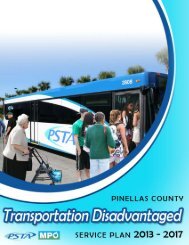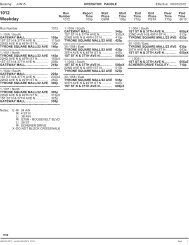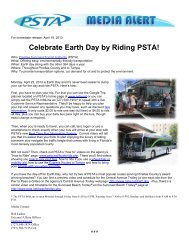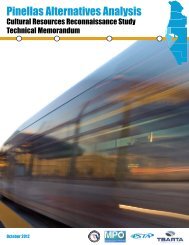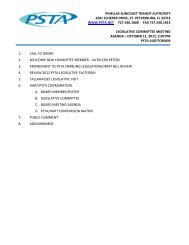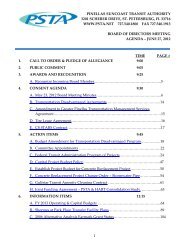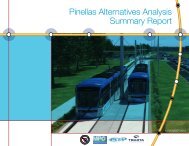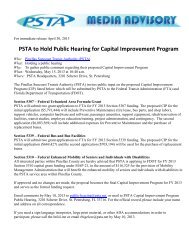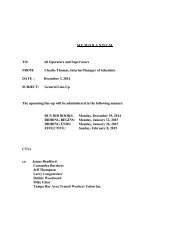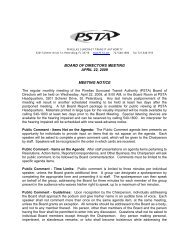DRAFT
FY 2020 - PSTA
FY 2020 - PSTA
- No tags were found...
Create successful ePaper yourself
Turn your PDF publications into a flip-book with our unique Google optimized e-Paper software.
Transit Network – The transit route network for all PSTA routes was updated to reflect 2009conditions, the validation year for the model. The transit network in TBEST required various edits toreflect the current route alignments and service characteristics in Pinellas County, including:o Generating bus stops by using a 1/8-mile interval between stops and 1/4-mile intervalbetween express bus stops, which do not necessarily correlate to current stops on theground;o Matching service span to existing service spans;o Modifying headways, also known as the frequency with which a bus will arrive at a stop(e.g. one bus every 60 minutes or one bus every 30 minutes);o Establishing passenger travel times on board a bus; ando Defining special generators.Demographic Data – The demographics used as the base input for the TBEST model are derivedfrom the 2000 Census and 2007 InfoUSA spatial and tabular databases. The model uses aCensus-Block-level personal geodatabase as the format for spatial distribution of populationdata. Varying data sets were used for TBEST because demographic data in TBEST is hardcodedand cannot be modified by end-users.Population and Employment Growth Rates – TBEST uses a socio-economic data growth functionto project population and employment data. A population growth rate and an employment growthrate were calculated using the 2035 TAZ forecasts developed for the Pinellas County LongRange Transportation Plan. System-wide annual growth rates for total population andemployment derived are 0.32 percent and 0.60 percent, respectively. As indicated previously,population and employment data are hard-coded into the model and cannot be modified by endusers.As applied, the growth rates do not reflect fluctuating economic conditions as experiencedin real time.TBEST Model Limitations – According to Rule 14-73.001 Florida Administrative Code, TBEST isthe FDOT-approved model for transit ridership forecasting as part of TDPs in Florida. It has longbeen a desire of FDOT to have a standard modeling tool for transit demand that could bestandardized across the State similar to the Florida Standard Urban Transportation ModelStructure (FSUTMS) model used by MPOs in developing LRTPs. However, while TBEST is animportant tool for evaluating improvements to existing and future transit services, model outputsdo not account for latent demand for transit that could yield significantly higher ridership, and,correspondingly, model outputs may over-estimate demand in isolated cases. In addition,TBEST cannot display sensitivities to external factors such as an improved marketing andadvertising program, changes in pricing service for customers, and other local conditions.Tindale-Oliver & Associates, IncPinellas Suncoast Transit AuthoritySeptember 2010 6-15 Transit Development Plan




